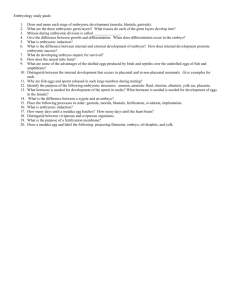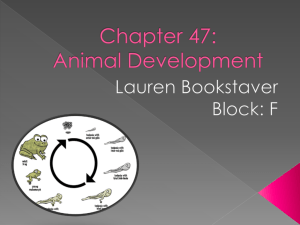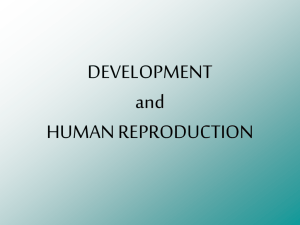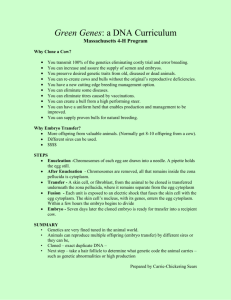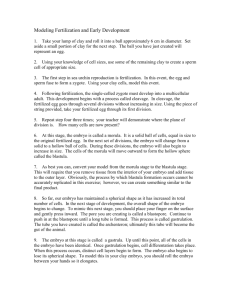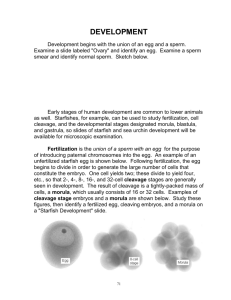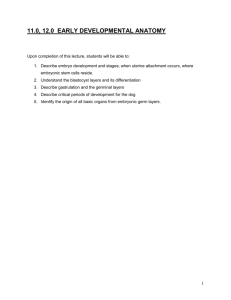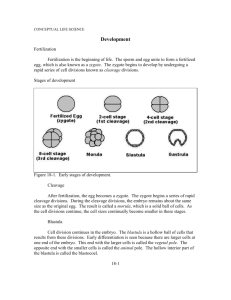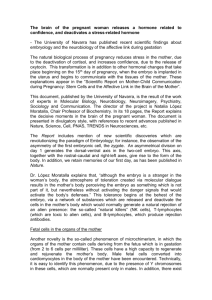Lab 11 Study Guide
advertisement
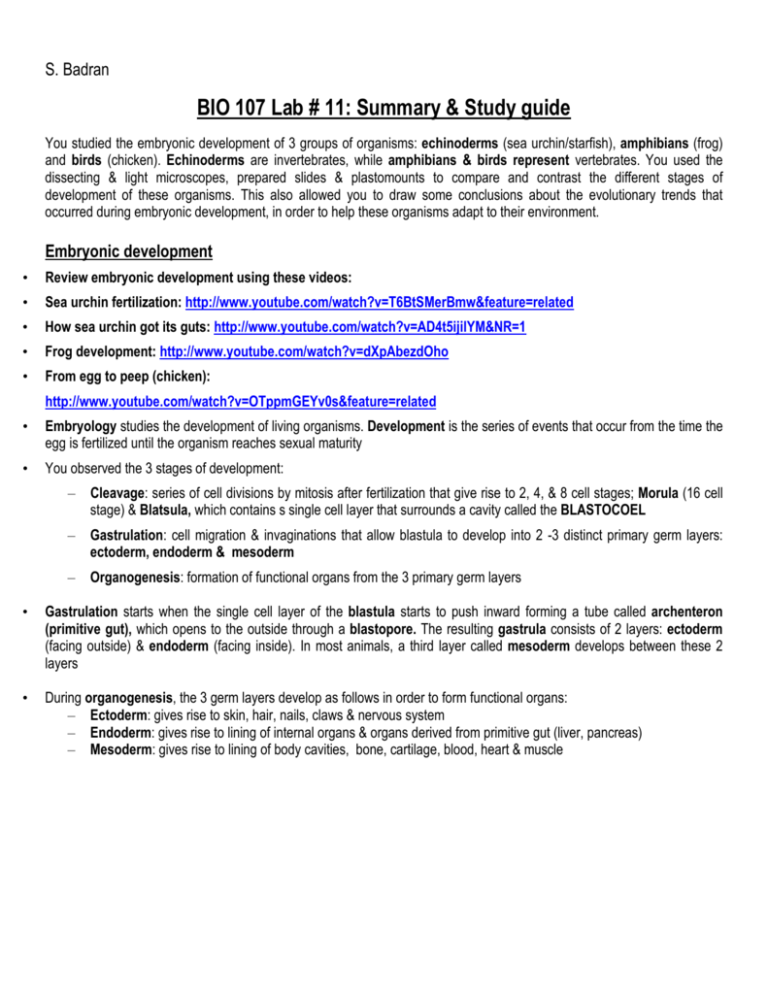
S. Badran BIO 107 Lab # 11: Summary & Study guide You studied the embryonic development of 3 groups of organisms: echinoderms (sea urchin/starfish), amphibians (frog) and birds (chicken). Echinoderms are invertebrates, while amphibians & birds represent vertebrates. You used the dissecting & light microscopes, prepared slides & plastomounts to compare and contrast the different stages of development of these organisms. This also allowed you to draw some conclusions about the evolutionary trends that occurred during embryonic development, in order to help these organisms adapt to their environment. Embryonic development • Review embryonic development using these videos: • Sea urchin fertilization: http://www.youtube.com/watch?v=T6BtSMerBmw&feature=related • How sea urchin got its guts: http://www.youtube.com/watch?v=AD4t5ijilYM&NR=1 • Frog development: http://www.youtube.com/watch?v=dXpAbezdOho • From egg to peep (chicken): http://www.youtube.com/watch?v=OTppmGEYv0s&feature=related • Embryology studies the development of living organisms. Development is the series of events that occur from the time the egg is fertilized until the organism reaches sexual maturity • You observed the 3 stages of development: – Cleavage: series of cell divisions by mitosis after fertilization that give rise to 2, 4, & 8 cell stages; Morula (16 cell stage) & Blatsula, which contains s single cell layer that surrounds a cavity called the BLASTOCOEL – Gastrulation: cell migration & invaginations that allow blastula to develop into 2 -3 distinct primary germ layers: ectoderm, endoderm & mesoderm – Organogenesis: formation of functional organs from the 3 primary germ layers • Gastrulation starts when the single cell layer of the blastula starts to push inward forming a tube called archenteron (primitive gut), which opens to the outside through a blastopore. The resulting gastrula consists of 2 layers: ectoderm (facing outside) & endoderm (facing inside). In most animals, a third layer called mesoderm develops between these 2 layers • During organogenesis, the 3 germ layers develop as follows in order to form functional organs: – Ectoderm: gives rise to skin, hair, nails, claws & nervous system – Endoderm: gives rise to lining of internal organs & organs derived from primitive gut (liver, pancreas) – Mesoderm: gives rise to lining of body cavities, bone, cartilage, blood, heart & muscle Ovum: unfertilized egg; nucleus is visible Sea urchin clear Frog Pigmented (half dark/half yellow) Surrounded by a thick gelatinous layer that swells up with water to separate eggs from each other Chicken Yolk serves as food source for embryo Layer of albumen forms a string that connects yolk to shell & acts as water reservoir Calcareous shell forms a hard external layer for protection & exchange of gases + water Fertilization External in water Zygote: Symmetrical zygote Fertilized egg surrounded by thick fertilization membrane “halo” to prevent entry of further sperm Cleavage External, Symmetrical External in water Asymmetrical zygote: dark area faces up, yellow area faces down. Dark pigment migrates to produce gray crescent Internal in female body Symmetrical zygote External, Asymmetrical producing 2 opposite poles with different sized cells Internal, Symmetrical single cell layer of blastula starts to push inward forming a tube called archenteron, which opens to outside through a blastopore pigmented cells form external layer of gastrula; yolk shrinks to form a plug. Gastrula forms, egg is then laid & contains an embryo with 3 germ layers floating on top of yolk. Neurula None: no nervous system Neurula develops; gives rise to neural tube; which later forms brain & spinal cord Embryo Embryo hatches as free swimming larva; which metamorphoses into adult embryo breaks from jelly layers; it hatches as free swimming tadpole, which metamorphoses into land dwelling frog Gastrula Mesoderm forms in roof of archenteron to give rise to notochord & later to vertebral column Neurula develops: gives rise to neural tube; which later forms brain & spinal cord embryo develops inside egg which is covered with several extra embryonic layers: • amnion on inside provides “fluid” in • • • • • which embryo floats to prevent desiccation chorion on outside transports gases & nutrients Allantois excrete waste & develop into blood vessels Yolk sac provides nutrients to chick for days after hatching Amniotic fluid fills up the cavity between the amnion on inside & chorion on outside In chicken, organogenesis takes place over 96 hours to give rise to: • somites, neural tube, notochord ( 24 hour embryo) • allantois, which give rise to heart & blood vessels (48 hour embryo) • limb buds & limbs (72 hour embryo) • extra-embryonic membranes (96 hour embryo) Study Guidelines: • Review the similarities & differences of the stages of development using the lab manual, PowerPoint presentation & videos/animations. • Review this document to summarize and check your understanding and to review the new terms. • Make sure you can distinguish well between the stages of development of these 3 organism by indicating the similarities & differences. • Relate some of the characteristic features of development of each organism to its environment and life style to show how it is well adapted to its environment.

